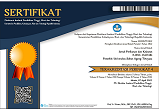Analysis of Code of Conduct Responsibilities Fisheries (CCRF) on Fishing Gear in Dumai
Abstract
Keywords
Full Text:
PDFReferences
Astarini JE, Haluan J, Wisudo SH, Monintja D, Simbolon D. 2011. Pengembangan Perikanan Tangkap Berbasis Code Of Concuct For Responsible Fisheries (CCRF) di Ternate, Provinsi Maluku Utara. Buletin PSP. XIX (1):127-137.
Arimoto T. 2000. Research and Education System of Fishing Technology in Japan.. Proceeding the 3 rd JSPS International Seminar on Fisheries sciences in Tropical Area Sustainable Fishing Technology in Asia Towards the 21 st Century. 8 March 2000. Tokyo University of Fisheries. Hlm 32-37.
Caddy JF, Seijo JC. This is more difficult than we thought! The responsibility of scientists, managers and stakeholders to mitigate the unsustainability of marine fisheries. Philosophical Transactions of The Royal Society B: Biological Sciences. 360(1453): 59-75.
Firdaus I, Fitri ADP, Sardiyatmo, Kurohman F. 2017. Analisis Alat Penangkap Ikan Berbasis Code Of Conduct For Responsible Fisheries (CCRF) Di Tempat Pelelangan Ikan (TPI) Tawang, Kendal. Indonesian Journal of Fisheries Science and Technology. 13(1):65-74.
Hosch G, Ferraro G, Failler P. 2011. The 1995 FAO Code of Conduct for Responsible Fisheries: Adopting, Implementing or Scoring Result. Marine Policy 2(35): 189-200.
Mardiah RS, Puspito G, Mustaruddin. 2016. Koreksi Kekenduran Trammel Net. Jurnal Teknologi Perikanan dan Kelautan. 7(1):1-10.
Mardiah RS, Pramesthy TD. 2019. Analisis Rancang Bangun Trammel Net (Jaring Tiga Lapis). Jurnal Ilmu Kelautan dan Perikanan Papua. 2(1):1-7.
Partadisastra MA. 2015. Persepsi Nelayan Pelabuhan Perikanan Muara Angke, Jakarta Utara terhadap Code Of Conduct For Responsible Fisheries (CCRF) [TESIS] Jakarta: Universitas Terbuka. 138 hlm.
Salfauz CR. 2015. Efektivitas Code Of Conduct For Responsible Fisheries Di Samudera Hindia: Studi Kasus Kerjasama Indonesia dan Australia Menanggulangi Illegal Unregulated Unreported (IUU) Fishing. Journal of International Relations. 1(2):57-63.
Sarianto D, Ikhsan SA, Haris RBK, Pramesthy TD, Djunaidi. Sebaran Daerah Penangkapan Alat Tangkap Sondong Di Selat Rupat Perairan Kota Dumai. Jurnal Ilmu-Ilmu Perikanan dan Budidaya Perairan. 14(1): 1-6.
Sumardi Z, Sarong MA, Nasir M. 2014. Alat Penangkap Ikan yang Ramah Lingkungan Berbasis Code Of Conduct For Responsible Fisheries di Kota Banda Aceh. Agrisep. 15(2):10-18.
DOI: http://dx.doi.org/10.33512/jpk.v9i2.6684
Refbacks
- There are currently no refbacks.



_-_Copy1.png)